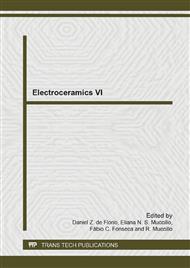[1]
J. Hays, A. Punnoose, R. Baldner, M.H. Engelhard, J. Peloquin, K.M. Reddy, Relationship between the structural and magnetic properties of Co-doped SnO2 nanoparticles, Phys. Rev. B 72 (2005).
DOI: 10.1103/physrevb.72.075203
Google Scholar
[2]
D.A.A. Santos, M.A. Macedo, Study of the magnetic and structural properties of Mn-, Fe-, and Co-doped ZnO powder, Physica B 407 (2012) 3229-3232.
DOI: 10.1016/j.physb.2011.12.073
Google Scholar
[3]
N.S. Ferreira, L.G. Abraçado, M.A. Macêdo, Room-Temperature Ferromagnetism in Chemically Synthesized Ce0. 97Cr0. 03O2−δ Nanopowders, J. Supercond. Nov. Magn. 26 (2013) 2549-2552.
DOI: 10.1007/s10948-012-1567-4
Google Scholar
[4]
P.C.A. Brito, D.A.A. Santos, J.G.S. Duque, M.A. Macedo, Structural and magnetic study of Fe-doped CeO2, Physica B 405 (2010) 1821-1825.
DOI: 10.1016/j.physb.2010.01.054
Google Scholar
[5]
A. Bouaine, R.J. Green, S. Colis, P. Bazylewski, G.S. Chang, A. Moewes, E.Z. Kurmaev, A. Dinia, Appearance of Ferromagnetism in Co-Doped CeO2 Diluted Magnetic Semiconductors Prepared by Solid-State Reaction, J. Phys. Chem. C 115 (2011) 1556-1560.
DOI: 10.1021/jp1088096
Google Scholar
[6]
D.Q. Gao, J. Zhang, G.J. Yang, J.L. Zhang, Z.H. Shi, J. Qi, Z.H. Zhang, D.S. Xue, Ferromagnetism in ZnO Nanoparticles Induced by Doping of a Nonmagnetic Element: Al, J. Phys. Chem. C 114 (2010) 13477-13481.
DOI: 10.1021/jp103458s
Google Scholar
[7]
X.B. Chen, G.S. Li, Y.G. Su, X.Q. Qiu, L.P. Li, Z.G. Zou, Synthesis and room-temperature ferromagnetism of CeO2 nanocrystals with nonmagnetic Ca(2+) doping, Nanotechnology 20 (2009).
DOI: 10.1088/0957-4484/20/11/115606
Google Scholar
[8]
G.Z. Xing, J.B. Yi, D.D. Wang, L. Liao, T. Yu, Z.X. Shen, C.H.A. Huan, T.C. Sum, J. Ding, T. Wu, Strong correlation between ferromagnetism and oxygen deficiency in Cr-doped In2O3-delta nanostructures, Phys. Rev. B 79 (2009).
DOI: 10.1103/physrevb.79.174406
Google Scholar
[9]
J. Rodriguez-Carvajal, FullProf: A Rietveld refinement and pattern matching analysis program (Version: October 2013), in, Laboratoire Léon Brillouin (CEA-CNRS), France, (2013).
Google Scholar
[10]
B.D. Cullity, S.R. Stock, Elements of X-Ray Diffraction, 3rd ed., Prentice-Hall, New Jersey, USA, (2001).
Google Scholar
[11]
J. Lu, Z.Z. Fang, Synthesis and characterization of nanoscaled cerium(IV) oxide via a solid-state mechanochemical method, J. Am. Ceram. Soc. 89 (2006) 842-847.
DOI: 10.1111/j.1551-2916.2005.00829.x
Google Scholar
[12]
I. Kosacki, V. Petrovsky, H.U. Anderson, P. Colomban, Raman spectroscopy of nanocrystalline ceria and zirconia thin films, J. Am. Ceram. Soc. 85 (2002) 2646-2650.
DOI: 10.1111/j.1151-2916.2002.tb00509.x
Google Scholar
[13]
I.H. Campbell, P.M. Fauchet, The Effects of Microcrystal Size and Shape on the One Phonon Raman-Spectra of Crystalline Semiconductors, Solid State Comm. 58 (1986) 739-741.
DOI: 10.1016/0038-1098(86)90513-2
Google Scholar
[14]
J.E. Spanier, R.D. Robinson, F. Zheng, S.W. Chan, I.P. Herman, Size-dependent properties of CeO2-y nanoparticles as studied by Raman scattering, Phys. Rev. B 64 (2001).
Google Scholar
[15]
Z.D. Dohcevic-Mitrovic, M.J. Scepanovic, M.U. Grujic-Brojcin, Z.V. Popovic, S.B. Boskovic, B.M. Matovic, M.V. Zinkevich, F. Aldinger, The size and strain effects on the Raman spectra of Ce1-xNdxO2-d (0 <= x <= 0. 25) nanopowders, Solid State Comm. 137 (2006).
DOI: 10.2298/sos0703281r
Google Scholar
[16]
W.H. Weber, K.C. Hass, J.R. Mcbride, Raman-Study of CeO2 - 2nd-Order Scattering, Lattice-Dynamics, and Particle-Size Effects, Phys. Rev. B, 48 (1993) 178-185.
Google Scholar
[17]
N. Paunovic, Z. Dohcevic-Mitrovic, R. Scurtu, S. Askrabic, M. Prekajski, B. Matovic, Z.V. Popovic, Suppression of inherent ferromagnetism in Pr-doped CeO2 nanocrystals, Nanoscale 4 (2012) 5469-5476.
DOI: 10.1039/c2nr30799e
Google Scholar
[18]
N.J.C. Ingle, R.H. Hammond, M.R. Beasley, Growth of the Cr oxides via activated oxygen reactive molecular beam epitaxy: Comparison of the Mo and W oxides, J. Appl. Phys. 89 (2001) 4631-4635.
DOI: 10.1063/1.1355286
Google Scholar
[19]
C. Xu, M. Hassel, H. Kuhlenbeck, H.J. Freund, Adsorption and Reaction on Oxide Surfaces - NO, NO2 on Cr2O3(111)/Cr(110), Surface Sci. 258 (1991) 23-34.
DOI: 10.1016/0039-6028(91)90897-2
Google Scholar
[20]
A. Zunger, S. Lany, H. Raebiger, The quest for dilute ferromagnetism in semiconductors: Guides and misguides by theory, Physics 3 (2010) 53.
DOI: 10.1103/physics.3.53
Google Scholar


